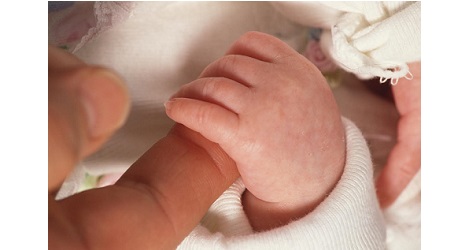
Baby’s touch is the most developed of senses from birth and helps to shape that precious early bond between you and baby. Encouraging the sense of touch can also help baby reach key development milestones. There are some easy ways to stimulate your baby’s sense of touch from birth, take a look at these…
1. Skin-to-skin contact
Hold baby close, as if you’re not already! The simple kangaroo care method (encouraged for premature babies) is a great way to create a strong bond for new parents, especially dads. It is simply a way of carrying your baby as kangaroos carry their babies. Strip baby down to just a nappy, hold him upright against your bare chest and use your top as a kangaroo’s pouch to keep baby warm. Simple, and lovely for you both!
2. Cuddle and keep close
Cuddles are just as important as your baby grows, in fact they are even more important. All those lovely cuddles, rocks, caresses and keeping baby close to your chest all help your baby’s familiarity with your body and offer comfort and stimulation important for baby development, and lovely for you!
3. Encourage grasping
There’s nothing more precious than your newborn grabbing your finger with his entire tiny hand. Not only cute, but also an important first developmental milestone. You may have noticed how even newborn babies instinctively curl their little fingers around one of yours when you stroke their palm using your finger. This first grasp and sense of touch is both comforting and reassuring for your baby. Let them hold on for as long as they can.
4. Embrace baby massage
Why not try a baby massage class? It’s a great bonding activity for you and baby to do together but also has some real benefits for baby. Massage stimulates the central nervous system that triggers the production of a feel-good hormone called serotonin. Research backs the benefits of baby massage as it contributes to healthy weight gain, growth and social development. Make sure the room is warm and draught-free before stripping your baby down.
5. Chew, chew, chew
There will come a stage when it seems your baby cannot help but put everything in his mouth, and we do mean everything! This can be alarming for new parents, but we should actually be encouraging it. The mouth is full of touch sensors and your baby will learn a lot from exploring different shapes and textures as he sucks, chews and dribbles. Obviously, some items are not meant for mouths, so always keep a close eye.
6. Create a texture treasure trove
Reading a baby touch and feel book together is a very rewarding way to bond with your baby. Spend time on each page letting your baby explore the different textures and sensations on each page using his fingers. Try explaining the different textures such as ‘hard’ or ‘soft’. This fun activity will help your baby is learn how to collect and process information through the power of touch.
7. Splash about in the bath
Babies usually love the sensation of being submerged in water. And the opportunity to splash about helps them to discover the laws of cause and effect. Use some baby-friendly bubble bath to enhance their bath time experience. As they get older they will enjoy exploring their sense of baby touch further by scooping, blowing and playing with the foam.
8. Encourage fun with finger foods
Once weaning is underway, there is a whole new avenue of opportunity for your baby to explore his sense of touch. Be on hand to supervise, but as far as possible let him try and feed himself. He will love experiencing all the different touch sensations as he picks up the food with his fingers and pops them in his mouth. It’s also great practice for him to develop his pincer grasp and fine motor skills, just be prepared for the mess, more will end up on the floor and windows than in his mouth!
9. Help develop spatial awareness
Spatial awareness and your baby’s sense of touch develop in tandem. At two months, you’ll still have to put things in your baby’s palm for them to hold and explore but as they get older give them the opportunity to pick things up themselves and play with toys which have different parts which can be grabbed, pushed, pulled and twisted. By the time they're five months old, your baby will be gleefully lifting, holding and playing with objects while inadvertently assessing distance and space using their sense of touch.
10. Give in to messy play
The tactile experience of playing with different textured elements like water, clay and sand while messy, is a great forum for learning and stimulation. During messy play, babies can develop their fine motor skills, coordination as well as compare different feelings and textures with their hands. If you can’t abide mess at home, take your baby to a stay and play group where they can make a mess you won’t have to clean up afterwards! Messy play should be supervised at all times.